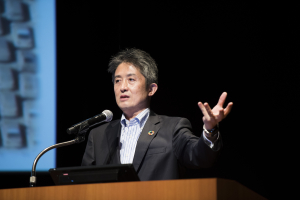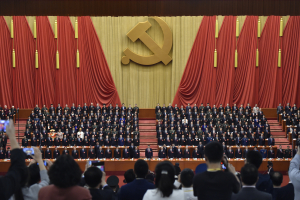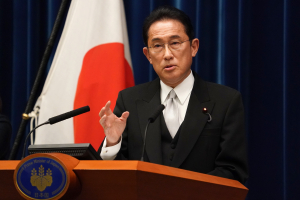
Funding the Policies to Boost Japan’s Birthrate
October 6, 2023
R-2023-048E
Hoping to avert a demographic crisis, the Japanese government has drafted an “unprecedented” policy package aimed at boosting the birthrate, but its plans for funding the ¥3.5 trillion initiative remain unclear. Motohiro Sato calls for the introduction of pay-as-you-go budget rules to tighten fiscal discipline.
* * *
The cabinet of Prime Minister Fumio Kishida has unveiled plans for an “unprecedented” ¥3.5 trillion increase in family-policy spending aimed at boosting the country’s low fertility rate and stemming population decline. But its plans for financing the initiative remain murky. With vague references to expenditure reform (unspecified spending cuts), the government has tried to assure the public that it will avoid adding to the national burden. The real question, however, is not whether the public will bear the burden but how, and the government needs to make this clear. In the following, I will examine the funding options in the larger context of fiscal discipline and accountability.
Background
In 2022, Japan’s total fertility rate fell to a historic low of 1.26, and the number of live births dropped below 800,000, according to the Ministry of Health, Labor, and Welfare (Summary of Vital Statistics). The National Institute of Population and Social Security Research projects that by 2070, Japan’s population will dwindle by roughly 30%, falling to around 87 million (Population Projections for Japan [2023 revision]). The working-age population (15–64 years of age) will shrink from 75 million in 2020 to 45 million in 2070, and those aged 65 years and older will make up about 40% of the total population. A shrinking labor force will act as a drag on economic growth, and a growing imbalance between the mostly elderly beneficiaries of social insurance (pensions, healthcare, and nursing care) and the working people whose premiums support those programs could threaten the sustainability of our social security system. At the root of this “quiet crisis” is Japan’s ever-falling birthrate.
In response, the Kishida administration has announced plans for a massive new spending package aimed at stemming the decline in births, arguing that the next six or seven years are Japan’s “last chance” to address the problem and avoid disastrous consequences. The government has called for concentrated efforts over the next three years, with ¥3.5 trillion in new spending allocated to childcare and other support for families with children. But such ambitious new programs—like Japan’s burgeoning defense budget—need funding sources, which the government has yet to clearly identify funds.
The basic policy released by the prime minister’s Children’s Future Strategy Council on June 13, 2023, cautions against any financing mechanism that would “hinder economic growth or reduce the incomes of young people and the child-rearing generation.” The focus, it says, should be on finding resources through “thoroughgoing expenditure reform,” along with “maximum use of existing budgetary resources.” Yet, citing the need for urgent action to address the declining birthrate, the plan also calls for the issuance of government bonds (“special children’s bonds”) to fund the spending increase. In addition, the government will establish a new special account, tentatively called the Children’s Fund, that will be charged with the centralized management of fiscal resources for boosting the birthrate. It promises to disclose and “visualize” the relationship between costs and specific benefits to prevent wasteful spending, but funding sources remain unclear.
Japan’s Social Security Benefits and Burdens (Fiscal 2022 Budget)
Source: Translated by the author from the Ministry of Health, Labor, and Welfare website.
A Tax by Any Other Name
For the past several decades, the bulk of social security funding has come from consumption tax revenues and social insurance premiums—that is, individual and employer contributions to the pension, health insurance, and long-term (nursing) care insurance schemes. (Individual co-payments also help finance health care and nursing care). Of the ¥131 trillion budgeted for social security in fiscal year 2022, premiums covered about ¥74 trillion. The consumption tax and other taxes paid for the ¥52 trillion classified as “public expenditure” (see figure).
The consumption tax is an earmarked tax whose revenues must be allocated primarily to expenditures on pensions, medical and nursing care, and family support policies (Consumption Tax Act, article 1, paragraph 2). In a globalizing economy, the consumption tax is highly compatible with medium- and long-term growth. But increases in the tax have proven extremely unpopular among voters and politicians, and Prime Minister Kishida has said he will not raise taxes to finance the new initiative.
Enter the proposal for a “child-rearing solidarity fund,” to be financed by a surcharge on public health insurance premiums. Although social insurance contributions are essentially a tax on employers and employees (who share the burden), rate increases have thus far provoked far less backlash than consumption tax hikes. This may be partly a matter of semantics. While the term “consumption tax” is a constant reminder of an added burden on consumers, the term “premium” suggests a more direct connection between the money one pays in and the benefits one receives. Whoever devised the solidarity-fund scheme doubtless sought to take advantage of this difference in perception.
But the plan’s veneer is already wearing off. Originally, the government hoped to secure about ¥1 trillion for children and child rearing in this manner, but the business community and organized labor attacked the proposal. The costs of social security programs, from which the elderly benefit the most, already fall disproportionately on working people, who have seen their premiums rise sharply. Moreover, businesses have argued that an increase in social insurance contributions would undercut their efforts to boost wages, which have finally begun rising after years of virtual stagnation. Keidanren has called for a “best mix” of funding sources, including the consumption tax.
Picking One’s Poison
Whether the issue is beefing up the military or supporting families with children, the nation must ultimately bear the costs of new spending. It is just a question of how. In the case of family policies, the choices boil down to a consumption tax hike, an increase in social insurance premiums, and cuts in other major social expenditures, such as pension and health-care benefits. One may argue that now is a bad time—just as the economy is recovering from the COVID-19 pandemic—to talk about further burdening businesses and individual taxpayers. But what guarantee is there that economic conditions will be better farther down the road? Another pandemic or large-scale natural disaster could occur at any time. By issuing deficit-covering bonds and delaying tax increases, we are unilaterally transferring the burden of our own risks (the pandemic, defense, etc.) to future generations without assuming any of theirs in return. Surely, we have a responsibility to deal with our own risks so that future generations will have the financial latitude to deal with theirs.
In terms of policymaking, any plan for new benefits or services should include provisions for financing them. This was originally the thinking behind the “integrated reform of the tax and security systems.” The idea was to raise the consumption tax by 5 percentage points, from 5% to 10%, using one fifth of the added revenue to enhance social security benefits (including family policies, as well as pensions, healthcare, and nursing care) and the remaining four fifths to ensure the social security system’s sustainability. But before long, the issues of burdens and benefits were being discussed separately. All the debate over measures to limit the growth of pension benefits seemed to focus on the immediate consequences for today’s seniors instead of weighing that impact against the alternatives—raising pension contributions or raiding the pension reserve fund and jeopardizing the system for future retirees. Our policy leaders need to grapple with such choices and make a decision. If they opt for enhanced services, they need to secure the necessary funding by raising taxes (or social insurance premiums). If they want to avoid higher taxes (or premiums), they need to keep services at a level consistent with the current burden. Whatever the decision, the fiscal consequences must be made clear.
The same principle applies to policies to boost the birthrate. The most straightforward options for financing such measures are cuts in other social security spending, higher social insurance premiums, or an increase in the consumption tax. The government must choose one or a combination of those mechanisms—otherwise, it will end up relying on deficit-financing bonds by default. If it wants to avoid increasing social insurance contributions, then it must raise the consumption tax or cut social security spending elsewhere—on healthcare and nursing care, for example. If, in the end, it cannot raise enough by any of those means, then it must rethink the scale of the new spending program. Policymakers need to make voters and politicians understand that there are budgetary constraints on the expansion of programs, including those aimed at boosting the birthrate.
Time is, of course, an important consideration in policy planning. If expenditure reform requires careful deliberation, and immediate economic conditions make tax or premium increases unfeasible, then government bonds may need to be issued as an emergency, stopgap provision. But in such a case, repayment methods—either tax hikes or premium increases—must be specified from the outset.
A Pay-as-You-Go Budget
There is no denying that fiscal discipline has become lax in Japan. By fiscal discipline, I do not mean fiscal austerity or retrenchment; I am referring to the government’s ability to control the size of the budget and its allocation. An integral aspect of responsible budgeting is offsetting increases in one area with decreases elsewhere. Unless this is done, there is little to prevent the budget from spiraling out of control. Japan’s social security spending lacks discipline because there has been almost no effort to offset new spending programs—including family policies—with cuts in existing programs.
The government’s fiscal 2023 Basic Policy on Economic and Fiscal Management states, “To achieve sustainable economic growth, it is important to strive for optimal allocation of our resources. To this end we must clarify our budgetary priorities throughout the budget and commit fully to results-oriented spending.” This is a sound precept, in keeping with the principle of “wise spending.” But to carry it out, we must continuously evaluate our policies’ effectiveness on the basis of objective results. We must determine the effectiveness and wisdom of individual programs, and we also need to look at the bigger picture, setting budget priorities by ranking the programs in each department or policy area according to cost-effectiveness.
What this means in practice is that all budget increases for specific programs, whether they pertain to defense or family policy, should be accompanied by offsetting adjustments to existing programs in the same general area. For example, an increase in child-rearing support should be offset by an adjustment to other social services, such as health care or nursing care. In the category of health care, this would involve reducing compensation to providers, limiting drug coverage, and boosting co-payments. Such adjustments do not imply that existing programs are ineffective but only that they may be less so than newer ones and therefore lower on the list of priorities.
What I am advocating is essentially a pay-as-you-go budget rule. Under a typical pay-as-you-go scheme, any new policies or legislation involving increases in direct spending or decreases in revenue must be made budget-neutral by means of offsetting measures, such as spending cuts and tax increases adopted during the same fiscal year. Such a rule was first legislated in the United States under the 1990 Omnibus Budget Reconciliation Act, passed during the administration of President George H. W. Bush to control deficit spending, which had soared during the 1980s.
Because our social security system is so complex, with multiple options (taxes, social insurance premiums, etc.) for balancing the books, it is easy to assume that somebody else will foot the bill. Like the prisoners’ dilemma, it creates a situation in which people’s instinct to act in their own self-interest leads to a negative outcome for the entire group. The best way to avoid such an outcome is to clarify at the outset which policy variable—consumption tax, social insurance premiums, or other alternative—will be used to offset any new expenses and balance the books. If the government proposes to rely heavily on expenditure reform to fund a ¥3.5 trillion initiative, it must identify the programs targeted for cuts and clarify in advance how it will make up any shortfall (in case reform stalls) through a tax increase or additional premium surcharge.
The impulse among our current leaders is to avoid such difficult choices. The Basic Policy on Economic and Fiscal Management and Reform 2022 speaks of the need for “stable financial resources” to promote child welfare policies but avoids specifics, promising only to “consider a new framework in which all participants in the society and the economy, including companies, work together to bear a wide range of burdens from a standpoint of fairness.” Keidanren Chairman Masakazu Tokura has suggested that we improvise the “best mix, including the consumption tax and a variety of other tax resources” to cover such burdens, but not everyone agrees on what constitutes a “best mix.” Without some clarity on the offsetting mechanism, the accounting is likely to become muddled.
In Conclusion
The government has designated the next three years as a period of intensive effort to reverse the decline in fertility, but three years will hardly be sufficient to cure Japan’s demographic ills. Should the planned measures become permanent programs, we will need to find stable funding mechanisms to cover their costs. Otherwise, we could end up relying on deficit-financing bonds and forcing our children to repay the principal and interest, which would defeat the whole purpose of those programs.
Some have argued that financing measures to boost fertility with bonds is acceptable, since such policies—like infrastructure—are an investment from which future generations will benefit. To be sure, the benefits of policies like child allowances extend to the next generation, that is, today’s children. But we must also keep in mind the heavy burden of taxes and social insurance premiums that today’s children will have to bear to support the current generation’s pension benefits, health care, and nursing care. In effect, they will shoulder the double burden of financing their own benefits, such as education, while caring for the older generation. The government must not sidestep the critical issue of program funding.







































